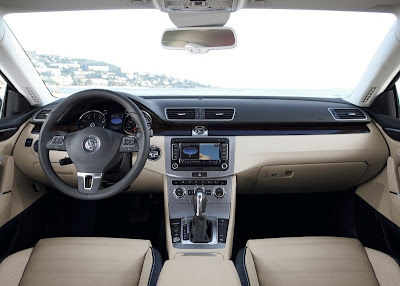CAR GARAGE | Volkswagen CC (2013) | All petrol engines also have battery regeneration functionality. The TDI engines output 103 kW / 140 PS and 125 kW / 170 PS. The petrol engines of the European versions CC develop an impressive 118 kW / 160 PS, 155 kW / 210 PS and 220 kW / 300 PS of power. In the USA, the Volkswagen will once again launch with 147 kW / 200 PS (TSI) and 206 kW / 280 PS (FSI) petrol engines. All engines up to 210 PS may be combined with a dual clutch gearbox (DSG) as an option. The European six-cylinder version (300 PS) is delivered with DSG and 4MOTION all-wheel drive as standard equipment. The 200 PS TSI - a popular engine in America - attains a fuel economy of 21 (City) / 33 mpg (Highway) with manual gearbox and 22/31 mpg in the DSG version.
Standard equipment Volkswagen CC has always included Such features as dual tailpipes, 17-inch alloy wheels with mobility tires, sport seats, Various cup holders, chrome surrounds on switches and water vents, air conditioner, sport chassis, 'Auto-hold' function, hill start assistant, automatic control of running lights with 'Leaving home' and 'Coming home' functions, automatic boot lid opening from the interior, DCC dynamic chassis control (from 125 kW / 170 PS) and, of course, the ESP electronic stabilization program and 6 airbags. Standard exterior features include the added That were already Mentioned bi-xenon headlights, static cornering lights, headlight washing system, LED rear lights, LED license plate illumination and more prominent side sill flares.
New interior features are standard on all That models: fatigue detection system, RCD 310 radio-CD system, front head restraints with longitudinal 'X adjustment', stainless steel door sill plates and (in Germany) the multifunction steering wheel. Already Offered since 2011, and no less innovative, fuel-saving is a free-Wheeling modes for all 100, 103 and 125 kW versions with a DSG dual clutch gearbox; it decouples the engine from the transmission during coasting phases, improving fuel economy.
This system detects waning driver concentration and warns the driver with an acoustic signal lasting five seconds; a visual message also Appears in the instrument cluster recommending That the driver take a break from driving. Right at the beginning of each car trip, the system analyzes the driver's steering behavior characteristic. Underway, then the fatigue detection system continually evaluates Such as steering angle signals. Traffic sign detection: This system detects speed limit signs and no-passing zones via camera, and up to three of these signs are shown on the instrument cluster display in front of the driver as well as in the navigation system display. The system also acquires no-passing signs and entrance and exit signs municipality, and it calls the driver's attention to country-specific maximum allowable speeds in cities.
The team led by Klaus Bischoff, Head of Design for the Volkswagen Brand, reworked the front and rear body sections of the Volkswagen CC. New alloy wheels and car colors complement other exterior modifications. Front end. In front, the eye is draw to the new designs of the radiator grille, bi-xenon headlights and bonnet. Optional LED daytime running lights are integrated in the headlight housings. Even more than on the previous model, the entire area of the new front bumper, headlights and radiator grille That exhibits clean lines correspond 1:1 to Volkswagen 'design DNA' styling.






No comments:
Post a Comment